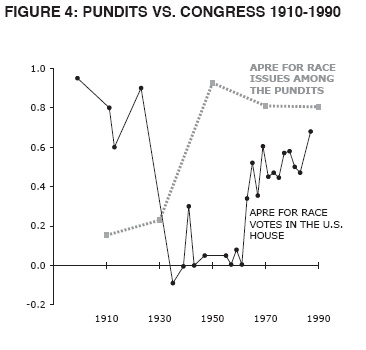
Yesterday I discovered a remarkable political scientist, Georgetown’s Hans Noel. I learned a lot from him over lunch, but it was his seminar that blew me away. He presented results from two papers: “Interpreting Legislative Ideal Points with Help From Ideological Discourse” and “The Coalition Merchants: Testing the Power of Ideas with the Civil Rights Realignment.”
Digest version: Noel does for pundits what Poole and Rosenthal did for Congressional roll-call voting. He assembled a big data set of all the written issue positions staked out by major pundits in major outlets at twenty-year intervals, then did factor analysis. In the seminar, he shared results from 1850 to 1990; the actual papers span shorter periods. Details from “The Coalition Merchants”:
The data are the recorded positions of pundits in major political publications on the issues of the day. The database includes a variety of actors, such as The New York Times editorial board, periodic correspondents with a publication, and major figures such as Herbert Croly or William Graham Sumner. It includes some elected officials, such as Woodrow Wilson and Theodore Roosevelt, who also act as intellectuals. It also includes excerpts and summaries of opinions expressed elsewhere, in speeches or books.
This paper analyzes sets of opinions at 20-year intervals from 1910 to 1990… Publications studied include The Atlantic Monthly, The Christian Science Monitor, Harper’s Monthly, Human Events, The International Monthly, The Los Angeles Times, The Nation, The National Review, The New Republic, The New York Times, The New-Englander, The North American Review, Scribner’s, The Wall Street Journal and The Washington Post… For each opinion article, researchers recorded the author, source and the issue(s) on which an opinion was taken, and what position (for or against) was taken.
Using this data, Noel is able to extend Poole and Rosenthal’s main results: Pundits’ positions, like legislators’ votes, are largely one-dimensional, though there was one major period of chaos and realignment. The empirics by themselves are impressive, but he also shows that pundits’ period of chaos and realignment precedes politicians’ by about a decade. While it’s not decisive proof, it’s consistent with a story where intellectuals change their minds first, and activists, the rank-and-file, and politicians gradually get into line. Nice diagram:
[Note: One key fact you can’t see in this diagram is that in the earlier period, it was Democrats, not Republicans, who tended to be anti-black.]
Details:
In the 1910s, a single dimension does not do a very good job of describing ideological conflict among the pundits, but the first dimension is an economic one. Race, however, is not related. This is true in the 1930s as well, but in the 1950s, the fit of a one-dimensional model has increased greatly. Many more issues are on the first dimension, and notably for the current discussion, racial issues are now as important as economic issues. Beginning in 1950, and continuing in 1970 and 1990, race and economics are on the same dimension.
But in the 1950s, according to Figure 2, race has just fallen off the primary dimension in Congress. In Congress, race and economics were highly related from the Civil War up until 1921, when pro-business Republicans voted for anti-lynching laws. Among ideologues, the tie between racial sympathy and economic conservatism established in the antebellum period has evaporated by 1910. In the 1910s, race is orthogonal to economics among intellectuals. It largely remains so in 1930. Thus the intellectuals herald both the decoupling of race from ideology (1910 among pundits vs. 1921 to 1937 in Congress) and its new association with the other side (1950 vs. 1970 or later).

READER COMMENTS
Daniel Klein
Feb 18 2011 at 9:24am
When you speak of ideology being one-dimensional, what is the dimension? What variable is low or high on the axis of that dimension?
Zac Gochenour
Feb 18 2011 at 10:29am
@Prof Klein, that dimension is almost always the conservative-liberal spectrum when talking about the modern US, although the research shown here shows a chaos and realignment that has at least something to do with another dimension, race.
In the past, the single dimension might have been something like catholicism vs protestantism; what’s interesting is that it seems to gravitate toward a single dimension even when many of the positions taken within the ideology don’t seem united by some underlying philosophy. If you ask Robin Hanson, much of it boils down to some conflict between forager and farmer ways.
Jeff
Feb 18 2011 at 10:47am
The reason for the one-dimensionality of opinions is probably that most people have an “us against them” mentality most of the time that blinds them to the obvious hypocrisy of their own views. Just look at how people change their views on the legitimacy of Senate filibusters depending on which party is being filibustered. Or whether the presidency is too “imperial”, or whether or not deficit spending is a bad idea.
Whose side you’re on is more important than what that side stands for. Most of us never really graduated from junior high.
jsalvatier
Feb 18 2011 at 11:55am
Does that graph show a fraction of variance explained by dimension 1 or what?
Douglass Holmes
Feb 18 2011 at 12:53pm
I like the quote, “Ideologues want to figure out right and just policies, convince others to agree with them, and then hope to see their policies enacted.” That’s you, Bryan, trying to argue for a right and just policy with regard to immigration.
Steve Sailer
Feb 18 2011 at 3:00pm
Does the study measure the demographics of the pundits?
Comments are closed.